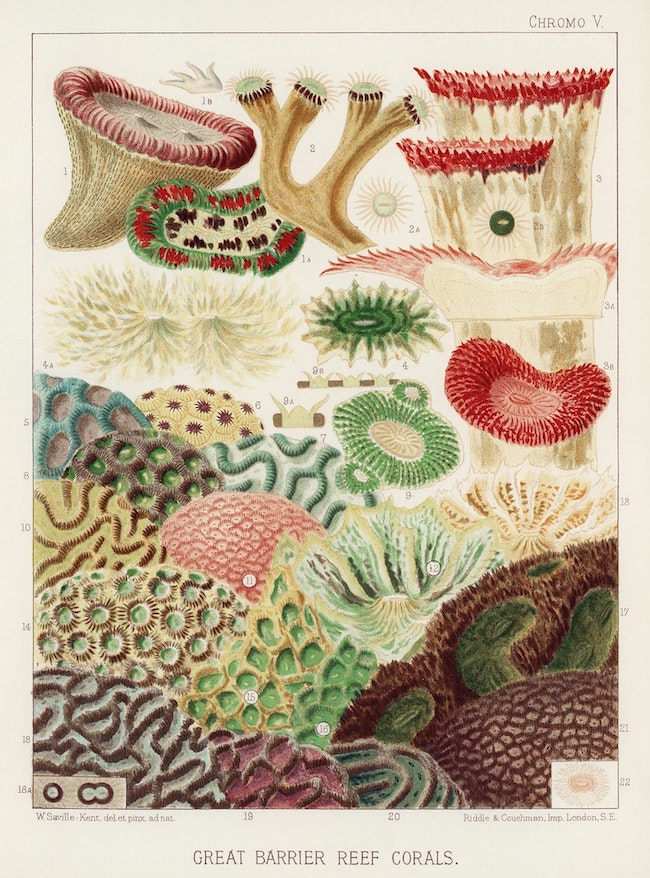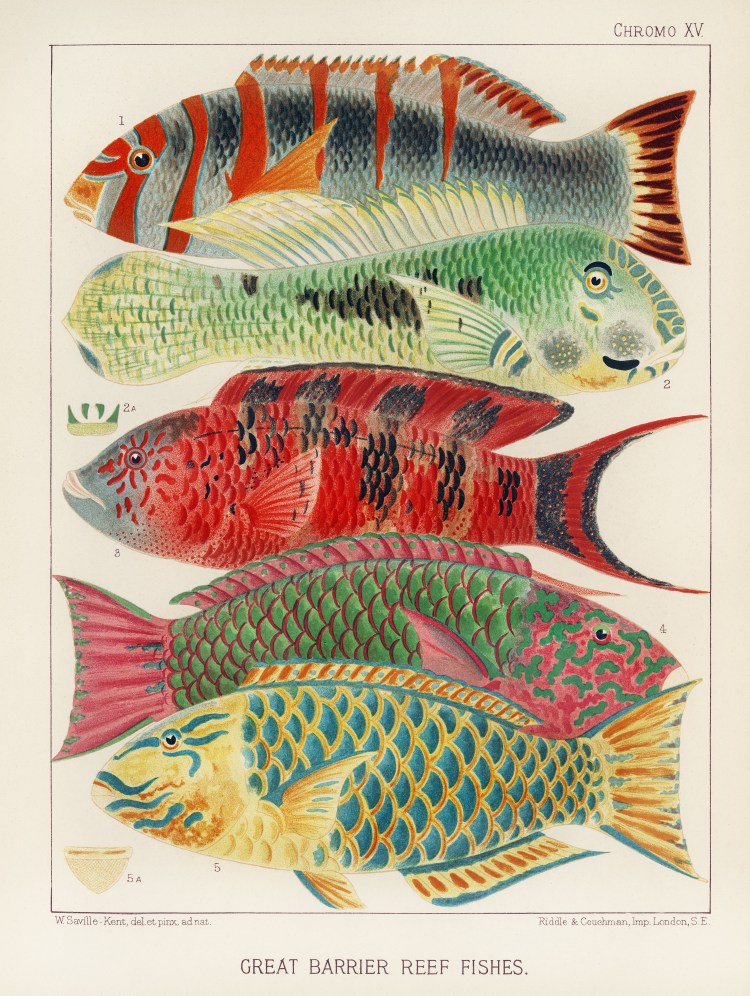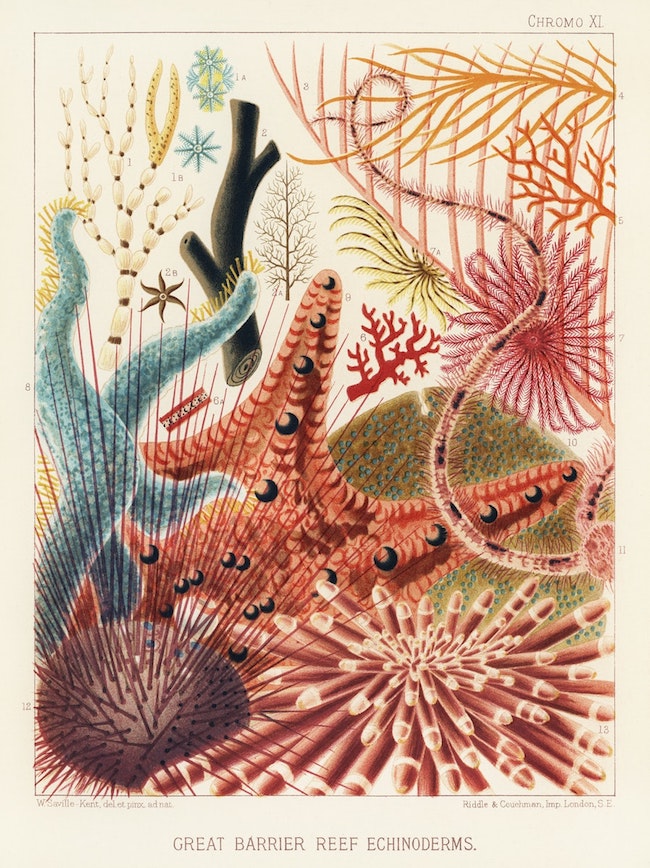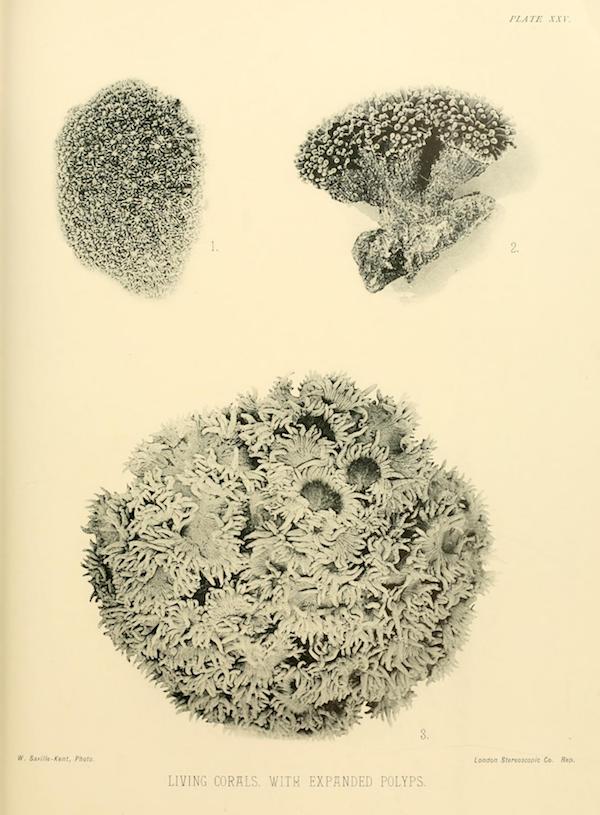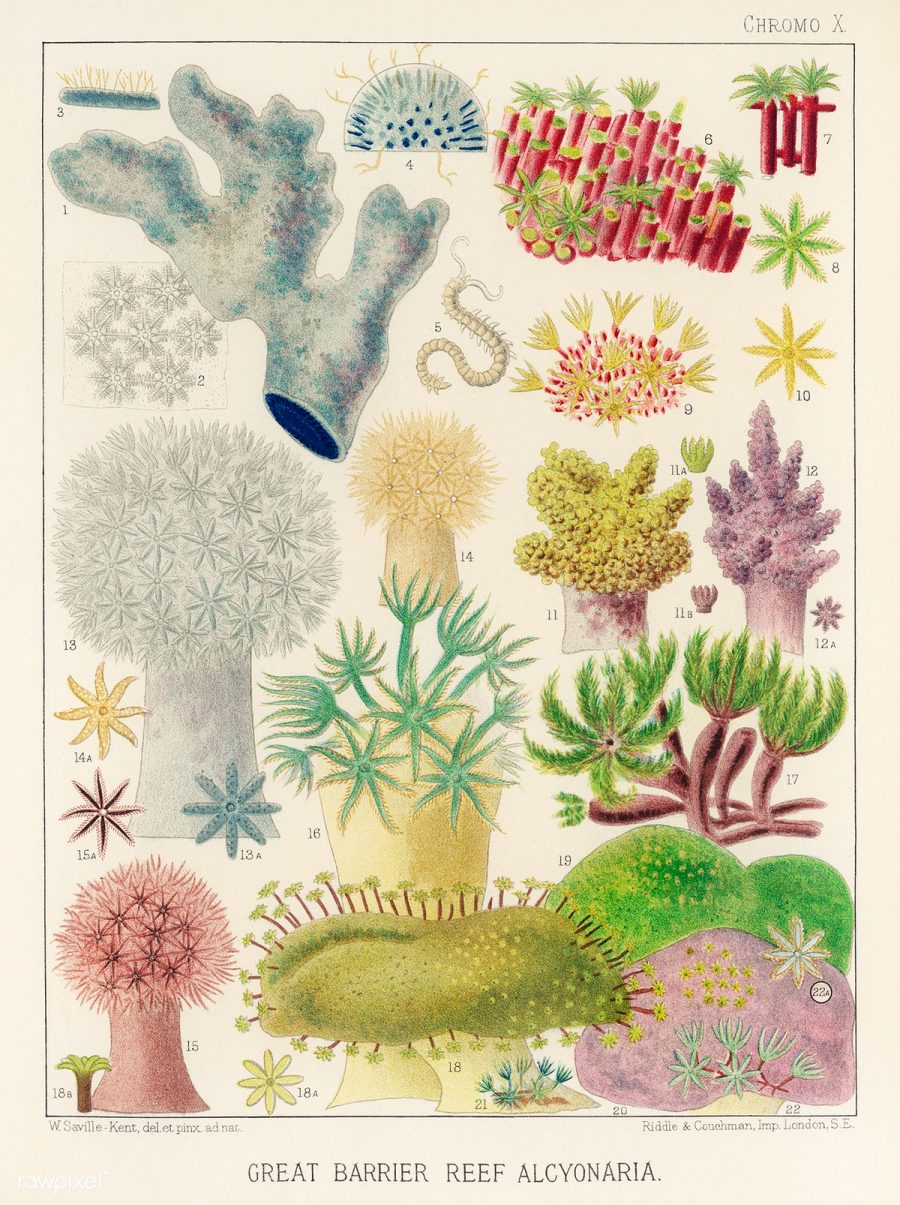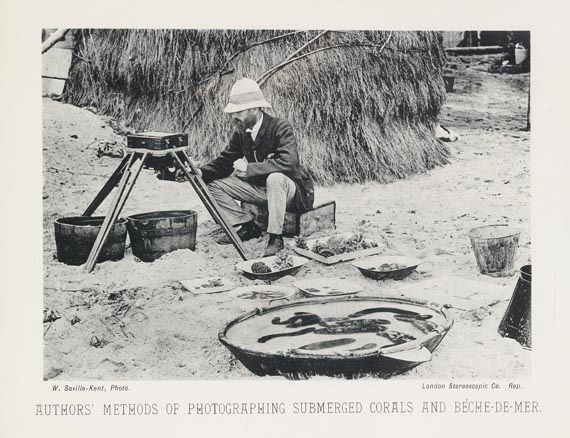[Most Recent Entries] [Calendar View]
Friday, June 14th, 2019
| Time | Event |
| 8:00a | The Brilliant Colors of the Great Barrier Revealed in a Historic Illustrated Book from 1893
Paul Simon’s famous lyric about everything looking worse in black and white Saville-Kent, a naturalist whose work in various British aquariums eventually led to a gig rebuilding depleted Tasmanian oyster beds, fell hard for the colorful fish, bêche-de-mer, corals, sponges, turtles, and other marine species he encountered in Australia. He photographed the Great Barrier Reef while serving in Queensland as Commissioner of Fisheries. 48 of his images were published in the aforementioned book, offering readers an unprecedented armchair tour of a coral reef, albeit in black and white.
While Saville-Kent definitely achieved his goal of furthering the public’s awareness of the reef, he also upstaged himself by including 16 color lithographs inspired by his original watercolors.
These plates, by London-based lithographers Riddle and Couchman—whose work usually ran toward portraits of well-born gentlemen—exude a lively Seussian appeal.
Saville-Kent’s carefully captured fish, echinoderms, and anemones literally pale in comparison to the bright specimens the lithographers, who presumably lacked his firsthand experience of the forms they were depicting, brought to such vibrant life in the back of the book.
These days, alas, the Great Barrier Reef resembles Saville-Kent's photos more closely than those gorgeous lithographs, the victim of back-to-back bleaching events brought on by pollution-related climate change. Saville-Kent is buried at All Saints Churchin Milford-on-Sea, Hampshire, England. His grave is decorated with coral. Browse a digital copy of The Great Barrier Reef of Australia: its products and potentialities here. Related Content: Two Million Wondrous Nature Illustrations Put Online by The Biodiversity Heritage Library Ayun Halliday is an author, illustrator, theater maker and Chief Primatologist of the East Village Inkyzine. Join her in NYC on Monday, June 17 for another monthly installment of her public domain-based variety show, Necromancers of the Public Domain. Follow her @AyunHalliday. The Brilliant Colors of the Great Barrier Revealed in a Historic Illustrated Book from 1893 is a post from: Open Culture. Follow us on Facebook, Twitter, and Google Plus, or get our Daily Email. And don't miss our big collections of Free Online Courses, Free Online Movies, Free eBooks, Free Audio Books, Free Foreign Language Lessons, and MOOCs. |
| 4:34p | Hear What’s Likely the Only Known Recording of Frida Kahlo’s Voice (1954) Perhaps no artist in modern history, save Andy Warhol, has been so well documented, and self-documented, as Frida Kahlo, or has used documentary methods, surrealist and otherwise, to so unflinchingly confront ideas about disability, gender, sexuality, national identity, and relationships. These qualities make her the perfect celebrity artist for our times, but unlike the average 21st century star making art out of self-presentation, Kahlo’s voice has never been heard, though she lived in a time almost as saturated with mass media—of the radio, TV, and film variety—as our own. That is, perhaps, until now, with the unearthing of what the National Sound Library of Mexico believes to be a recording of her voice, “taken from a pilot episode of 1955 radio show El Bachiller [“The Bachelor”],” writes Steph Harmon at The Guardian. The show “aired after her death in 1954,” likely the following year. Though the program does not introduce her by name, the presenter does refer to her as recently deceased, and she does read an essay about her husband Diego Rivera, which happens to be written by Frida Kahlo. The case seems fairly conclusive. Previously the little evidence of what she sounded like came from written descriptions, such as French photographer Gisèle Freund’s characterization of her voice as “melodious and warm.” Hear for yourself what is very likely the recorded voice of Frida Kahlo in the audio above. In her typically florid yet unsparing style she paints a verbal portrait of Rivera full of unflattering physical detail and layers of emotion and admiration. In one English translation, she calls him “a huge, immense child, with a friendly face and a sad gaze. Rivera's "high, dark, extremely intelligent and big eyes rarely hold still. They almost pop out of their sockets because of their swollen and protuberant eyelids—like a toad’s.” His huge eyes seem “built especially for a painter of spaces and crowds.” The Mexican muralist, she says is like “an inscrutable monster.” These are the words of a writer, we must remember, who was passionately in love with her subject, but who did not pretend to ignore his physical oddities. As she had practiced loving herself, she loved and admired Rivera because of his unique appearance, not in spite of it. Researchers are making continuing efforts to verify that the voice on the recoding is Kahlo and searching through about 1,300 other episodes of the show, recorded for Televisa Radio, to find out if there are any more recordings of her. Given Frida’s flamboyant persona and minor art stardom in her lifetime, it’s hard to imagine we won’t hear more of her, if this is in fact her, as other archives reveal their secrets. Related Content: Frida Kahlo’s Passionate Love Letters to Diego Rivera A Brief Animated Introduction to the Life and Work of Frida Kahlo Josh Jones is a writer and musician based in Durham, NC. Follow him at @jdmagness Hear What’s Likely the Only Known Recording of Frida Kahlo’s Voice (1954) is a post from: Open Culture. Follow us on Facebook, Twitter, and Google Plus, or get our Daily Email. And don't miss our big collections of Free Online Courses, Free Online Movies, Free eBooks, Free Audio Books, Free Foreign Language Lessons, and MOOCs. |
| 7:00p | Scenes from HBO’s Chernobyl v. Real Footage Shot in 1986: A Side-By-Side Comparison Audiences today can't get enough of history, especially history presented as a podcast or a prestige television series. Best of all is the historical prestige television series accompanied by its own podcast, currently exemplified by Chernobyl, HBO's five-episode dramatization of the events leading up to and the aftermath of the titular Soviet nuclear disaster. "The material culture of the Soviet Union is reproduced with an accuracy that has never before been seen in Western television or film — or, for that matter, in Russian television or film," The New Yorker's Masha Gessen writes of the show. "Soviet-born Americans — and, indeed, Soviet-born Russians — have been tweeting and blogging in awe at the uncanny precision with which the physical surroundings of Soviet people have been reproduced." But along with all the praise for the accuracy on Chernobyl's surface has come criticism of its deeper conception of the time and place it takes as its setting: "its failure to accurately portray Soviet relationships of power," as Gessen puts it, or to acknowledge that "resignation was the defining condition of Soviet life. But resignation is a depressing and untelegenic spectacle. So the creators of Chernobyl imagine confrontation where confrontation was unthinkable." Among the chilling truths of the real story of the Chernobyl disaster is how many people involved knew beforehand what could, and probably would, go wrong with the reactor that exploded on April 26, 1986. But Chernobyl, adhering to "the outlines of a disaster movie," instead pits a lone truth-teller against a set of self-serving, malevolent higher-ups. Chernobyl creator and writer Craig Mazin is not unaware of this, as anyone who has listened to the miniseries' companion podcast knows. On each episode, Mazin discusses (with Peter Sagal from Wait Wait...Don't Tell Me!, incidentally) the complications of bringing such a complex event, and one that involved so many people, to the screen three decades later, and the inherent tradeoffs involved between historical faithfulness and artistic license. The video essay from Thomas Flight above combines clips from the Chernobyl podcast with not just clips from Chernobyl itself but the real-life source footage that inspired the show. The six-minute viewing experience showcases the often-astonishing recreations Chernobyl accomplishes even as it casts doubt on the possibility of ever truly recreating history on the screen. But watching creators take on that increasingly daunting challenge is precisely what today's audiences can't get enough of. Related Content: A Haunting Drone’s-Eye View of Chernobyl 200 Haunting Videos of U.S. Nuclear Tests Now Declassified and Put Online A is for Atom: Vintage PR Film for Nuclear Energy Based in Seoul, Colin Marshall writes and broadcasts on cities, language, and culture. His projects include the book The Stateless City: a Walk through 21st-Century Los Angeles and the video series The City in Cinema. Follow him on Twitter at @colinmarshall, on Facebook, or on Instagram. Scenes from HBO’s Chernobyl v. Real Footage Shot in 1986: A Side-By-Side Comparison is a post from: Open Culture. Follow us on Facebook, Twitter, and Google Plus, or get our Daily Email. And don't miss our big collections of Free Online Courses, Free Online Movies, Free eBooks, Free Audio Books, Free Foreign Language Lessons, and MOOCs. |
| << Previous Day |
2019/06/14 [Calendar] |
Next Day >> |
